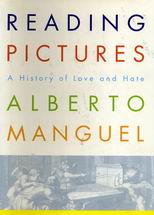
Reading Pictures
A History of Love and Hate
Manguel, Alberto
Publisher: Random House, New York, USA
Year Published: 2000
Pages: 338pp ISBN: 0-375-50302-1
Library of Congress Number: N7430.5 M274 2001 Dewey: 750'.1'9--dc21
Resource Type: Book
A meditation on the questions we ask ourselves when standing in front of a piece of art.
Abstract:
Reading Pictures is a meditation on the questions we ask ourselves when standing in front of a piece of art. The first section of the book, The Common Viewer, is unique from the other 11 sections because it focuses on the central idea of "The Image as Story." Although this section is not titled after a specific artist as the others in the book, the author's first impressions as a child of Van Gogh's painting 'Shipping Boats on the Beach at Saintes-Maries' influence the discussion within the chapter. The author illuminates how each picture tells either a hidden or explicit story similar to a book constructed of words. The viewers of the image are responsible for interpreting the picture into the "artificial vocabulary," which enables us to understand our experiences of the real world. These visual pieces of art are reproductions of reality, from which we derive additional fabricated images and meaningful associations. Furthermore, he questions if pictures create universal stories, which gain authority over time and thus evaluates whether images become limited in their meaning and scope in comparison to the dynamic interpretive nature of the written word. He concludes this chapter by proposing that we decipher a system for decoding images only after an image is born.
The subsequent sections of the book titled after inspiring artists examine the implications of interpreting an image in several different ways. Therefore, Manguel evaluates the image within various interpretive contexts: Absence, Riddle, Witness, Understanding, Nightmare, Reflection, Violence, Subversion, Philosophy, Memory, Theatre. Within each of these chapters Manguel tracks the development of artistic movements while factoring in important historical events that influenced the production of images. In his conclusion, Manguel argues that his book is incomplete in that he cannot adequately interpret all genres of art within the confines of a book. Yet he effectively summarizes the paradox of the image when he states that images evoke illusions of discovery in the human eye in reaction to arbitrary lines, lighting and colours. This fabricated and incidental sense of discovery, which lends meaning to these images that we create for our enjoyment, extends the illusion we are someone. Thus, a painting extends the world to us or us to the world and reminds us that we can create and recreate beauty despite the harsh realities of the world. Finally, he leaves the reader to question why we demand such intricate meanings and lessons from a merely random visual experience.
[Abstract by Amanpreet Dhami]
Table of Contents
Acknowledgments
1. The Common Viewer: The Image as Story
2. Joan Mitchell: The Image as Absence
3. Robert Campin: The Image as Riddle
4. Tina Modotti: The Image as Witness
5. Lavinia Fontana: The Image as Understanding
6. Marianna Gartner: The Image as Nightmare
7. Philoxenus: The Image as Reflection
8. Pablo Picasso: The Image as Violence
9. Aleijandinho: The Image as Subversion
10. C.-N. Ledoux: The Image as Philosophy
11. Peter Eisenman: The Image as Memory
12. Caravaggio: The Image as Theatre
Conclusion
Notes
Plate Credits
Index
Subject Headings


